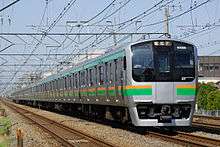E217 series
| E217 series | |
|---|---|
|
E217 series train on a Sōbu Line Airport Narita service, August 2009 | |
| In service | 1994–Present |
| Manufacturer | Tokyu Car, Kawasaki Heavy Industries, JR East (Niitsu/Ofuna) |
| Replaced | 113 series |
| Constructed | 1994–1999 |
| Refurbishment | 2008– |
| Number built | 745 vehicles (97 sets) |
| Number in service | 745 vehicles (97 sets) |
| Formation | 11+4 cars per trainset |
| Fleet numbers | Y1–51, Y101–Y146 |
| Operator(s) | JR East |
| Depot(s) | Kamakura |
| Line(s) served | Yokosuka Line, Sōbu Main Line |
| Specifications | |
| Car body construction | Stainless steel |
| Car length | 19,500 mm (64 ft 0 in) |
| Width | 2,950 mm (9 ft 8 in) |
| Doors | 4 per side |
| Maximum speed | 120 km/h (75 mph) |
| Traction system | Mitsubishi |
| Power output | 1,520 kW |
| Acceleration | 2.0 km/h/s |
| Deceleration | 3.3 km/h/s (emergency brake) |
| Electric system(s) | 1,500 V DC overhead catenary |
| Braking system(s) | Regenerative brake |
| Safety system(s) | ATS-P, ATS-SN, ATC (not service) |
| Track gauge | 1,067 mm (3 ft 6 in) |
The E217 series (E217系) is a suburban electric multiple unit (EMU) train type operated by East Japan Railway Company (JR East) in the Kantō region of Japan since 1994.[1]
Design
Introduced in 1994 to replace the 113 series EMUs running on the Sōbu Line (Rapid) and Yokosuka Line, it was the first outer-suburban train type in Japan to feature four pairs of doors per side on car. The basic design was developed from the 209 series commuter EMUs. It replaced all the Yokosuka Line 113 series trains by 1999. The trains were built jointly by Kawasaki Heavy Industries, Tokyu Car, and JR East (Niitsu and Ofuna factories).[2]
They use Mitsubishi GTO thyristors and VVVF inverters with Mitsubishi MT68 traction motors. Gear ratio is 97:16.
Operations
- Kashima Line (Sawara - Kashima-Jingū)
- Narita Line (Chiba - Narita Airport, Sawara)
- Sōbu Main Line (Tokyo - Narutō)
- Sōbu Main Line (Airport Narita to Narita Airport)
- Sotobō Line (Chiba - Kazusa-Ichinomiya)
- Uchibō Line (Chiba - Kimitsu)
- Yokosuka Line
Former operations
- Tokaido Main Line (Tokyo - Atami) (March 2006 - March 2015)[3]
Formations
11+4-car sets
11-car sets (Y1–Y51) and 4-car sets (Y101–Y146) based at Kamakura Depot[4]
| Car No. | +1 | +2 | +3 | +4 | 1 | 2 | 3 | 4 | 5 | 6 | 7 | 8 | 9 | 10 | 11 | |
|---|---|---|---|---|---|---|---|---|---|---|---|---|---|---|---|---|
| Numbering | KuHa E216-1000 | MoHa E216-2000 | MoHa E217-2000 | KuHa E217-2000 | KuHa E216-2000 | MoHa E216-2000 | MoHa E217-2000 | SaRo E216 | SaRo E217 | SaHa E217-2000 | SaHa E217-2000 | MoHa E216-1000 | MoHa E217 | SaHa E21 | KuHa E217 |
- Cars numbered in the -1000 and -2000 subseries have longitudinal bench seating.
- Cars 3, 9, and +3 are each fitted with one scissors pantograph.
Former 10+5-car Tokaido Main Line sets (March 2006 - March 2015)
10-car sets (F1–F3) and 5-car sets (F51–F53) based at Kōzu Depot for Tokaido Main Line services[4]
| Car No. | 1 | 2 | 3 | 4 | 5 | 6 | 7 | 8 | 9 | 10 | 11 | 12 | 13 | 14 | 15 | |
|---|---|---|---|---|---|---|---|---|---|---|---|---|---|---|---|---|
| Numbering | KuHa E216-2000 | MoHa E216-2000 | MoHa E217-2000 | SaRo E216 | SaRo E217 | SaHa E217-2000 | SaHa E217-2000 | MoHa E216-1000 | MoHa E217 | KuHa E217 | KuHa E216-1000 | MoHa E216-2000 | MoHa E217-2000 | SaHa E217 | KuHa E217-2000 |

- Cars numbered in the -1000 and -2000 subseries have longitudinal bench seating.
- Cars 3, 9, and 13 are each fitted with one scissors pantograph.
Interior
- Green car upper saloon with Suica card touch panels, August 2010
- Green car lower saloon with Suica card touch panels, August 2010
History
The E217 series trains entered revenue service from 3 December 1994.[4]
In March 2006, three 15-car trains were reformed as 10+5-car sets and transferred to Kōzu depot for use from 14 March 2006 on Tokaido Main Line duties out of Tokyo alongside E231 series trains. The sets were repainted into the same Shonan color scheme of orange and green bodyside stripes as applied to the E231s. As of April 2011, only one pair (F3+F53) remained at Kōzu depot.[4]
A programme of refurbishment on the fleet commenced from 2008. Externally, sets received lighter blue and cream stripes.
References
- ↑ JR全車輌ハンドブック2009 [JR Rolling Stock Handbook 2009]. Japan: Neko Publishing. 2009. pp. 269–270. ISBN 978-4-7770-0836-0.
- ↑ Saka, Masahiro (March 2014). "JR第1世代の車両・現況と概要" [JR 1st-generation rolling stock: Current situation and overview]. Tetsudō Daiya Jōhō Magazine (in Japanese). Vol. 43 no. 359. Japan: Kōtsū Shimbun. p. 23.
- 1 2 3 4 JR電車編成表 2011夏 [JR EMU Formations - Summer 2011]. Japan: JRR. May 2010. ISBN 978-4-330-21211-1.
Further reading
- 首都圏新系列車両PROFILE [Tokyo Area New-generation Rolling Stock Profile]. Japan: Ikaros Publishing. 15 April 2011. ISBN 978-4-86320-436-2.
External links
| Wikimedia Commons has media related to JR East E217. |
- JR E217 series (Japanese)